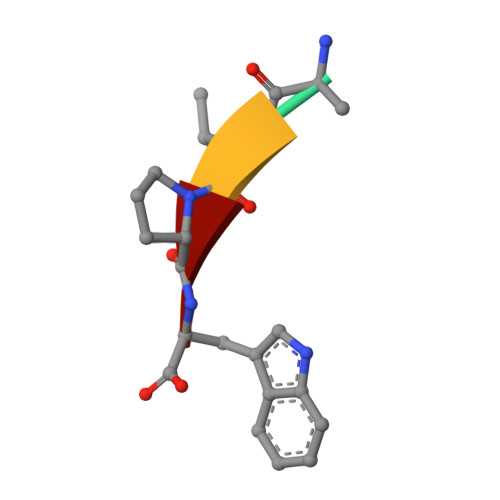Design, synthesis, and biological activity of a potent Smac mimetic that sensitizes cancer cells to apoptosis by antagonizing IAPs.
Zobel, K., Wang, L., Varfolomeev, E., Franklin, M.C., Elliott, L.O., Wallweber, H.J., Okawa, D.C., Flygare, J.A., Vucic, D., Fairbrother, W.J., Deshayes, K.(2006) ACS Chem Biol 1: 525-533
- PubMed: 17168540
- DOI: https://doi.org/10.1021/cb600276q
- Primary Citation of Related Structures:
2I3H, 2I3I - PubMed Abstract:
Designed second mitochondrial activator of caspases (Smac) mimetics based on an accessible [7,5]-bicyclic scaffold bind to and antagonize protein interactions involving the inhibitor of apoptosis (IAP) proteins, X-chromosome-linked IAP (XIAP), melanoma IAP (ML-IAP), and c-IAPs 1 and 2 (cIAP1 and cIAP2). The design rationale is based on a combination of phage-panning data, peptide binding studies, and a survey of potential isosteres. The synthesis of two scaffolds is described. These compounds bind the XIAP-baculoviral IAP repeat 3 (BIR3), cIAP1-BIR3, cIAP2-BIR3, and ML-IAP-BIR domains with submicromolar affinities. The most potent Smac mimetic binds the cIAP1-BIR3 and ML-IAP-BIR domains with a K i of 50 nM. The X-ray crystal structure of this compound bound to an ML-IAP/XIAP chimeric BIR domain protein is compared with that of a complex with a phage-derived tetrapeptide, AVPW. The structures show that these compounds bind to the Smac-binding site on ML-IAP with identical hydrogen-bonding patterns and similar hydrophobic interactions. Consistent with the structural data, coimmunoprecipitation experiments demonstrate that the compounds can effectively block Smac interactions with ML-IAP. The compounds are further demonstrated to activate caspase-3 and -7, to reduce cell viability in assays using MDA-MB-231 breast cancer cells and A2058 melanoma cells, and to enhance doxorubicin-induced apoptosis in MDA-MB-231 cells.
Organizational Affiliation:
Department of Protein Engineering, Genentech, Inc., South San Francisco, California 94080, USA.



















